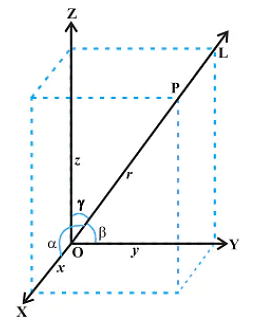Let the image of the point $P(2,-1,3)$ in the plane $x+2 y-z=0$ be $Q$ Then the distance of the plane $3 x+2 y+z+29=0$ from the point $Q$ is
- $2 \sqrt{14}$
- $\frac{22 \sqrt{2}}{7}$
- $3 \sqrt{14}$
- $\frac{24 \sqrt{2}}{7}$
The Correct Option is C
Approach Solution - 1

eq. of line PM 1x−2=2y+1=−1z−3=λ
any point on line=(λ+2,2λ−1,−λ+3)
for point ' m ’ (λ+2)+2(2λ−1)−(3−λ)=0
λ=\(\frac{1}{2}\)
Point m(\(\frac{1}{2}+2,2\times\frac{1}{2},\frac{-1}{2}+3\))
=(\(\frac{5}{2},0,\frac{5}{2}\))
For Image Q(α,β,γ)
\(\frac{\alpha + 2}{2}=\frac{5}{2},\frac{\beta-1}{2}=0\)
\(\frac{\gamma +3}{2}=\frac{5}{2}\)
Q:(3,1,2)
\(d=|\frac{3(3)+2(1)+2+29}{\sqrt{3^2+2^2+1^2}}|\)
\(d=\frac{42}{\sqrt{14}}=3\sqrt{14}\)
Approach Solution -2
Equation of line \( PM \): \[ \frac{x - 2}{1} = \frac{y + 1}{2} = \frac{z - 3}{-1} = \lambda \] Any point on this line is: \[ (\lambda + 2, 2\lambda - 1, -\lambda + 3) \] Solving for \( \lambda \), we get \( \lambda = \frac{1}{2} \). Thus, the midpoint \( M \) is: \[ \left( \frac{5}{2}, 0, \frac{5}{2} \right) \] For the image \( Q(\alpha, \beta, \gamma) \), we compute: \[ \alpha + 2 = \frac{5}{2}, \quad \beta - 1 = 0, \quad \gamma + 3 = \frac{5}{2} \] \[ \alpha = \frac{1}{2}, \quad \beta = 1, \quad \gamma = -\frac{1}{2} \] Using the distance formula: \[ d = \frac{|3(3) + 2(1) + (-1)(-1) + 29|}{\sqrt{3^2 + 2^2 + (-1)^2}} \] \[ = \frac{42}{\sqrt{14}} = 3\sqrt{14} \]
Top Questions on Three Dimensional Geometry
- If m:n is the ratio in which the point $\left(\frac{8}{5}, \frac{1}{5}, \frac{8}{5}\right)$ divides the line segment joining the points (2,p,2) and (p,-2,p) where p is an integer then $\frac{3m+n}{3n}=$
- TS EAMCET - 2025
- Mathematics
- Three Dimensional Geometry
- If $(\alpha, \beta, \gamma)$ is the foot of the perpendicular drawn from a point $(-1,2,-1)$ to the line joining the points $(2,-1,1)$ and $(1,1,-2)$, then $\alpha+\beta+\gamma=$
- TS EAMCET - 2025
- Mathematics
- Three Dimensional Geometry
- If A(2,1,-1), B(6,-3,2), C(-3,12,4) are the vertices of a triangle ABC and the equation of the plane containing the triangle ABC is $53x+by+cz+d=0$, then $\frac{d}{b+c}=$
- TS EAMCET - 2025
- Mathematics
- Three Dimensional Geometry
- Let $\pi_1$ be the plane determined by the vectors $\hat{i}+\hat{j}, \hat{i}+\hat{k}$ and $\pi_2$ be the plane determined by the vectors $\hat{j}-\hat{k}, \hat{k}-\hat{i}$. Let $\vec{a}$ be a non-zero vector parallel to the line of intersection of the planes $\pi_1$ and $\pi_2$. If $\vec{b} = \hat{i}+\hat{j}-\hat{k}$ then the angle between the vectors $\vec{a}$ and $\vec{b}$ is
- TS EAMCET - 2025
- Mathematics
- Three Dimensional Geometry
Show that the following lines intersect. Also, find their point of intersection:
Line 1: \[ \frac{x - 1}{2} = \frac{y - 2}{3} = \frac{z - 3}{4} \]
Line 2: \[ \frac{x - 4}{5} = \frac{y - 1}{2} = z \]
- CBSE CLASS XII - 2025
- CBSE Compartment XII - 2025
- Mathematics
- Three Dimensional Geometry
Questions Asked in JEE Main exam
- The number of ways, 5 boys and 4 girls can sit in a row so that either all the boys sit together or no two boys sit together is:
- JEE Main - 2025
- Permutation and Combination
- Given a thin convex lens (refractive index \( \mu_2 \)), kept in a liquid (refractive index \( \mu_1, \mu_1<\mu_2 \)) having radii of curvature \( |R_1| \) and \( |R_2| \). Its second surface is silver polished. Where should an object be placed on the optic axis so that a real and inverted image is formed at the same place?
- JEE Main - 2025
- Optics and Refraction
- To obtain the given truth table, the following logic gate should be placed at G

- JEE Main - 2025
- Logic gates

For the circuit shown above, the equivalent gate is:
- JEE Main - 2025
- Logic gates
Let \( f : \mathbb{R} \to \mathbb{R} \) be a twice differentiable function such that \[ (\sin x \cos y)(f(2x + 2y) - f(2x - 2y)) = (\cos x \sin y)(f(2x + 2y) + f(2x - 2y)), \] for all \( x, y \in \mathbb{R}. \)
If \( f'(0) = \frac{1}{2} \), then the value of \( 24f''\left( \frac{5\pi}{3} \right) \) is:
- JEE Main - 2025
- Differential Calculus
Concepts Used:
Three Dimensional Geometry
Mathematically, Geometry is one of the most important topics. The concepts of Geometry are derived w.r.t. the planes. So, Geometry is divided into three major categories based on its dimensions which are one-dimensional geometry, two-dimensional geometry, and three-dimensional geometry.
Direction Cosines and Direction Ratios of Line:
Consider a line L that is passing through the three-dimensional plane. Now, x,y and z are the axes of the plane and α,β, and γ are the three angles the line makes with these axes. These are commonly known as the direction angles of the plane. So, appropriately, we can say that cosα, cosβ, and cosγ are the direction cosines of the given line L.
